
The standard setting is the most suitable for Victron Gel Deep Discharge, Gel Exide A200, and tubular plate stationary batteries
(OPzS).
This setting can also be used for many other batteries: e.g. Victron AGM Deep Discharge and other AGM batteries, and many
types of flat-plate flooded batteries.
With VEConfigure the charge algorithm can be adjusted to charge any battery type (Nickel Cadmium batteries, Lithium-ion
batteries)
Absorption time
In case of the standard-setting ‘Four-stage adaptive with BatterySafe mode’ the absortion time depends on the bulk time
(adaptive charge curve), so that the battery is optimally charged.
Automatic equalisation charging
This setting is intended for flooded tubular plate traction or OPzS batteries. During absorption the voltage limit increases to 2,83V/
cell (34V for a 24V battery) once the charge current has tapered down to less than 10% of the set maximum current.
Not adjustable with DIP switches.
See ’tubular plate traction battery charge curve’ in VEConfigure.
Storage voltage, Repeated Absorption Time, Absorption Repeat Interval
See
.
Bulk Protection
When this setting is ‘on’, the bulk charging time is limited to 10 hours. A longer charging time could indicate a system error (e.g. a
battery cell short-circuit).
AC input current limit
These are the current limit settings for which PowerControl and PowerAssist come into operation:
48/3000/35-50
PowerAssist setting range, grid in-line
topology
9.5 A – 50 A
PowerAssist setting range, grid parallel
topology with external current
transformer
9.5 A – 100 A
Factory setting: maximum grid in-line topology value.
UPS feature
If this setting is ‘on’ and AC on the input fails, the MultiPlus-II switches to inverter operation practically without interruption.
The output voltage of some small generator sets is too unstable and distorted for using this setting – the MultiPlus-II would
continually switch to inverter operation. For this reason, the setting can be turned off. The MultiPlus-II will then respond less
quickly to AC input voltage deviations. The switchover time to inverter operation is consequently slightly longer, but most
equipment (most computers, clocks or household equipment) is not adversely impacted.
Recommendation:
Turn the UPS feature off if the MultiPlus-II fails to synchronise, or continually switches back to inverter
operation.
Dynamic current limiter
Intended for generators, the AC voltage being generated by means of a static inverter (so-called ‘inverter’ generators). In these
generators, engine rpm is reduced in case of low load: this reduces noise, fuel consumption and pollution. A disadvantage is that
the output voltage will drop severely or even completely fail in the event of a sudden load increase. More load can only be
supplied after the engine is up to speed.
If this setting is ‘on’, the MultiPlus-II will start supplying extra power at a low generator output level and gradually allow the
generator to supply more, until the set current limit is reached. This allows the generator engine to get up to speed.
This setting is also often used for ‘classical’ generators that respond slowly to sudden load variation.
Weak AC
Strong distortion of the input voltage can result in the charger hardly operating or not operating at all. If WeakAC is set, the
charger will also accept a strongly distorted voltage, at the cost of greater distortion of the input current.
Recommendation:
Turn WeakAC on if the charger is hardly charging or not charging at all (which is quite rare!). Also turn on the
dynamic current limiter simultaneously, and reduce the maximum charging current to prevent overloading the generator if
necessary.
MultiPlus-II 48V 3kVA 120V
Page 17
Configuration
















































